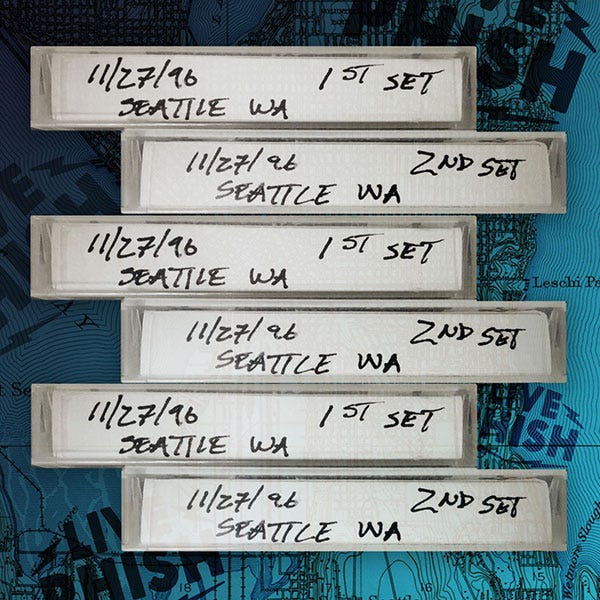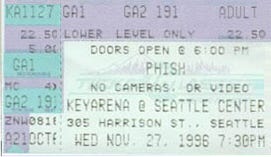SET 1: Julius > My Friend, My Friend, Ya Mar, Chalk Dust Torture, The Sloth, Uncle Pen, Free > Theme From the Bottom, Bold As Love
SET 2: Down with Disease -> Jesus Just Left Chicago > Scent of a Mule, Tweezer -> Sweet Emotion Jam -> Down with Disease, The Star Spangled Banner, Fire
ENCORE: Waste > Tweezer Reprise
Tonight’s Thanksgiving Eve show brought the kind of serendipity Phish could never refuse. Basically every time they played Seattle, they did some kind of tribute to Jimi Hendrix in his birthplace — usually Bold As Love, which appeared in their 1993, 1994, 1996, and 2014 stops in the Emerald City. But tonight, they happened to visit Seattle on Hendrix’s very birthdate, prompting a shoutout from the stage and the playing of three songs the guitarist was known for (even if Trey admits “we don’t do the anthem as well as he did”).
Hendrix was an idol for Trey and Phish from the start. When The Believer asked Trey when he first started to care about improvisation, the first album he mentions is Band of Gypsys. Fire is in one of the earliest Phish shows with a known setlist, 12/1/84, the first documented show at Nectar’s. They’ve never gotten around to doing Hendrix on Halloween, but they’ve covered five of his songs total, including two debuts in 2017 and 2021 — a time when new covers are few and far between — and teased many more.
But the influence of Hendrix on Phish arguably reached its crest in the fabled year of 1997. I’ve mentioned the min-maxing behind the new sound of 1997, with the minimalism coming from the band’s new obsession with play-acting The Meters and The JB’s (and later, Brian Eno). But the maximalist part of the 1997 aesthetic is pure Jimi, to the point that his Izabella became one of the year’s signature songs. Part of the year’s magic may be Trey rediscovering the power of playing rhythm guitar, but when he steps into the spotlight, his aggressiveness and overwhelming waves of sound would make Hendrix proud.
The two sides of the coin aren’t that different. Hendrix came up in backing bands for the likes of the Isley Brothers and Little Richard, playing sideman until his style (both musical and sartorial) became too distracting. Hendrix’s solo career brought those R&B chops into psychedelic rock, and he was heading towards a heavier funk sound with Buddy Miles and Band of Gypsys before his abrupt death. Phish were never going to make the full transition to funk band, so as they were looking to emphasize that genre, they needed a guide that had already blended funk with the classic and psych-rock territory they felt most comfortable with. Hendrix was the obvious choice.
And like many 1997 characteristics, there’s foreshadowing in 1996. At the Key Arena, Hendrix’s beyond-the-grave tutelage runs much deeper than the covers, as both highlight jams — a 23-minute Disease and the much-lauded “Diseezer” — are Hendrix-y through and through. The Disease is the first one to roll deep since the summer, and it steers off the road courtesy of Trey getting cozy with his wah pedal around the 8-minute mark. But this isn’t the laid-back strut of funk wah guitar, this is the hard-rock wah of Hendrix and “Purple Haze.” The jam also catches a second wind via a Hendrix-y riff that emerges around 15:00, delaying the inevitable mini-kit jam a further 4-1/2 minutes (Could you imagine Hendrix playing percussion? smdh).
After a diversion into some ZZ Top blues and another marathon Scent of a Mule (it’s the Brady Bunch one, if you must know), the band goes right back to that well for Tweezer. By the time the song gets to its jam, it has decelerated to a swampy pace, and Trey’s right back into that serrated “Manic Depression” Leslie/Uni-Vibe tone alternating with more hard wah. By this point, the classic rock floodgates have been flung completely open, and the band finds itself dipping into Aerosmith and The Stones before all is said and done.
But something else happens along the way. No offense to Noel Redding and Mitch Mitchell, but to my knowledge The Experience never exhibited the kind of magical telepathy that Phish casually exhibits right out of the “Sweet Emotion” tease. Trey’s playing the first half of the Disease closing riff at half-speed almost immediately, and it takes Page and Mike all of 45 seconds to figure out what he’s doing. As for Fish, well, him abruptly shifting it back to normal Disease speed causes a brief stumble, but only a minute after the idea pops into Trey’s head, they’re in full flight Disease-prise.
The mind-meld is a perfect example of late-tour chemistry (proving my last essay at least temporarily wrong) and may also have benefited from a mysterious two days of studio jamming in Seattle with Steve Lillywhite and John Siket. And it’s the reason why I’ll take Phish’s derivation of Hendrix over actual Hendrix any day. Genius that he was, Hendrix didn’t ever find a band that could keep up with him. I know it sounds like a stoned lot conversation, but Phish genuinely provides an answer to the question of “what if there was a Hendrix for four different instruments and they formed a band together, maannn?” It’s the edge that keeps them from grave-digging like a thousand other Hendrix worshippers, an influence they’ll build on instead of photocopy.






Second show back and I clearly saw that this Phish was not the Phish I remembered from 91/92 but some frankenphish out of the primordial soup. This is the show where I said, hey these guys deserve to have this level of success on their own merits and not on the back of old deadheads looking for somewhere new to go. Even though thats what many of me and my west coast friends were.
Tremendous review Rob. Great deep dive into Jimi. I remember listening to this tape on Maxell XLII’s in college. It’s a big 2nd set and you nailed it. Cheers